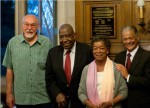The original photo caption contained an error and has been changed. See the bottom of the article for additional information.
The UCLA students trained like young troops going into battle.
They learned to roll up in a ball if attacked. They learned how to handle potentially dangerous situations without resorting to violence. They prepared their last testaments and wills – as a worst-case scenario.
The UCLA students’ Freedom Rides began in New Orleans in the summer of 1961 and lasted less than two days. They boarded a train to Mississippi as a way to protest the unlawful segregation of interstate transportation.
The chief of police was waiting to arrest them the moment they disembarked from the train in Jackson, Miss. The students spent 40 days in the notorious Mississippi State Penitentiary in Parchman for breach of peace.
“(The Freedom Rides) is something you can tell people, as they’re growing into men and women, what it means to stand up for their rights,” said Robert Singleton, who was a graduate student in economics when he went on a Freedom Ride from UCLA. “You (have) got to stand up for what you believe in.”
As one of its last gestures before finishing its term, this year’s Undergraduate Students Association Council unveiled a plaque in its Kerckhoff meeting room Tuesday in honor of UCLA’s past Freedom Riders.
Singleton and Bob Farrell, another UCLA Freedom Rider, asked last year’s council to commemorate the Freedom Rides UCLA students participated in, which had its golden anniversary in 2011.
“We looked at each other and said, ‘This is amazing,’” said Tamir Sholklapper, former Student Welfare commissioner. “This is the kind of activism that has been lost on campus, and we want student leaders to be reminded of it.”
Singleton and his wife, Helen, organized for 17 Freedom Riders – most of them UCLA students – to travel out of California into the deep South. Another group of UCLA Freedom Riders boarded a train bound for Mississippi but was arrested in Houston in 1961.
Some of the Freedom Riders had faced discrimination both while visiting the South and even going to college in Westwood, even though formal segregation did not exist in California. The local barber refused to cut black individuals’ hair, and some apartment owners wouldn’t let blacks move in.
“We were a young married couple, and we knew we wanted to have a family live in this country without the … segregation,” Singleton said. “We were determined that we weren’t going to sit back and let that happen.”
When they first set out, the Freedom Riders did not know each other very well. But in that summer they made a pledge to each other – a pledge not resort to violence, to protect each other and to care for one another, all while accepting the certainty of going to jail, Farrell said.
Their goal was to protest the segregation that still existed on interstate transportation in the South. In jail, the Freedom Riders sang when spirits ran low and gave academic lectures on anything from economics to anthropology to pass the time, but were threatened with fire hoses by the guards to stop their singing and lecturing, Singleton said. Sometimes, the guards put four or more people in the small solitary confinement room, where they had to take turns breathing from the small food tray hole, he added.
“Our ultimate destination was to go to Parchman prison, and we were looking forward to that,” Farrell said. “It was as though we were young troops. We were just looking forward to that moment of confrontation, which was going to be a test of ourselves.”
The new plaque also recognizes the 1961-1962 student council, which voted in favor of using student body funds to pay appeal bonds for UCLA Freedom Riders.
Without the bonds, the students would have had to return to Mississippi and spend another six months in Mississippi State Penitentiary, Singleton said.
“We were all supportive because we all saw what was going on in the South, and it was terrible,” said Jerry Chaleff, who was an upper division representative to the 1961-1962 USAC and personally knew some of the Freedom Riders. “We did it to make a statement, that we were supportive of what (the UCLA students) were doing.”
The Board of Control Committee in the UCLA administration, however, blocked the use of student funds for the Freedom Riders at the time, saying that student funds couldn’t be used for political causes, Singleton said.
“We argued that this was not a political cause, this was a moral cause. This went to the soul of the U.S.,” Singleton said.
In the end, it was some UCLA faculty members who came together to raise more than $17,000 for the Freedom Riders’ appeal bonds.
After the Freedom Rider movement, the federal government finally began cracking down on segregation in transportation and the black civil rights movement gained in support.
“It was a tremendous victory,” Singleton said. “It was one of those moments where you felt glad to be an American, especially a UCLA student.”
Correction: Max Pavesic is the leftmost person in the photo.

One of the best USAC special presentations I’ve ever seen. I advise everyone read the USAC meeting minutes because it’s full of OUR Bruin activist history. GO USAC!!! And congratulations to new council.